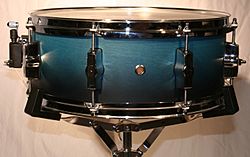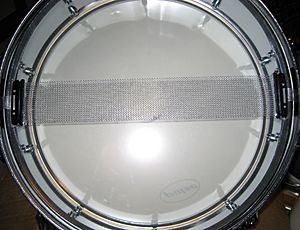Snare drum facts for kids

A drum kit snare drum.
|
|
| Percussion instrument | |
|---|---|
| Other names | Field drum, side drum |
| Classification |
|
| Hornbostel–Sachs classification | 211.212.11 (Individual double-skin cylindrical drums, one skin used for playing) |
| Developed | 13th century |
| Related instruments | |
| Tabor | |
A snare drum is a musical instrument. It makes a sharp, quick sound when hit with a drum stick. This sound comes from special wires stretched under the bottom drum skin. You can find snare drums in many places. They are used in orchestras, concert bands, and marching bands. They are also popular in parades and drum corps.
The snare drum is a key part of a drum set. A drum set is a group of instruments played by one drummer. It is used in many types of music. Drummers usually play snare drums with sticks. But they can also use brushes or rutes to make different sounds.
The snare drum is very versatile. It can make soft sounds even with a light touch. It can also create loud, powerful sounds. A very strong hit can make a thundering "crack" sound.
The snare drum came from the tabor. The tabor was a drum first used with a flute. Over time, the tabor changed into modern snare drums. These include the kit snare, marching snare, and piccolo snare. Each type has a different size and sound.
A snare drum in a pop music band often plays the backbeat. This helps create the rhythm. In marching bands, it might play the front beat. Kit snares are usually smaller than marching snares. Piccolo snares are the smallest of all.
You can easily spot a snare drum by its loud cracking sound. The sound's depth changes based on how the drum is made. Things like the drum head material, how tight it is, and the drum's size all affect the sound. The rim and shell materials also play a role.
A snare drum has two heads, usually made of plastic. It also has metal wires on the bottom head. These wires are called the snares. Sometimes, the wires are on the top head, or on both heads. The top head is called the batter head. This is where the drummer hits the drum. The bottom head is the snare head, where the snares are.
Metal rods keep the heads tight. Adjusting these rods changes the drum's sound. A lever called the strainer turns the snares on or off. If the snares are off, the drum sounds like a tom-tom. The rim is the metal ring around the top head. It can be hit to make a loud rimshot sound.
How to Play the Snare Drum
You can play the snare drum by hitting it with a drum stick. Other tools like brushes, rutes, or even hands can be used. These make a softer sound from the snare wires. When using a stick, drummers can hit the head, the rim, or the shell.
When the top head is hit, the bottom head vibrates. This makes the snares vibrate and creates the cracking sound. The snares can be turned off with a lever. Then the drum sounds like a tom-tom.
A Rimshot is a special way to hit the drum. You hit the head and the rim at the same time with one stick. In pop and rock music, many loud notes are played as rimshots. This makes a sharp, high-volume sound.
Another way to play is called "cross-stick" or "side-stick." You hold the stick tip on the drum head. Then you hit the stick's other end against the rim. Your hand mutes the head. This makes a dry, high-pitched click. It is common in Latin and jazz music.
"Ghost notes" are very light notes. They are played between the main beats. You hear them in music like funk and rhythm and blues. A drum roll is made by bouncing the sticks on the drum head. You can also make a roll by playing fast double strokes or single strokes. The snares help blend these strokes into one long sound.
The snare drum is often the first instrument to learn for a drum kit. Rudiments are basic patterns often practiced on a snare drum.
How Snare Drums Are Made
Snare drums can be made from many materials. These include wood, metal, acrylic, or composite materials like fiberglass. A common snare drum is about 14 inches (36 cm) wide.
Marching snare drums are deeper than other snares. They are often 12 inches deep. Snare drums for orchestras or drum kits are about 6 inches (15 cm) deep. Piccolo snare drums are even shallower, about 3 inches (7.6 cm) deep. Smaller snare drums, like soprano or firecracker drums, are about 8 inches (20 cm) wide. They are used for higher-pitched special effects.
Most wooden snare drum shells are made from layers of wood. These layers are heated and pressed into a cylinder shape. Some shells are made from one piece of wood. This wood is slowly rounded into a cylinder and glued. Inner rings can be added to keep the drum perfectly round.
Other shells are made from many wood rings glued together. These are then shaped on a lathe. Stave shells are made from vertical pieces of wood glued into a cylinder. This is like how a barrel is made. Solid shells are made from one hollowed-out piece of wood.
The heads or skins are the batter head (top) and the resonant head (bottom). The resonant head is thinner and not hit directly. Most modern drums use plastic (Mylar) skins. The batter head is usually thicker, sometimes with two layers. Rings or dots can be added to the heads. These help control the sound and ringing. Resonant heads are very thin. This lets them vibrate easily when the top head is played. Some special heads are made from Kevlar. These can be tuned very high. They make a very high-pitched cracking snare sound.
A new way to make snare drums sound better is called symmetrical venting. This means air can move easily through the drum. This quick air movement creates a smoother, stronger sound.
Images for kids
-
A line of marching snare drums in a high school marching band
See also
 In Spanish: Caja (instrumento musical) para niños
In Spanish: Caja (instrumento musical) para niños






